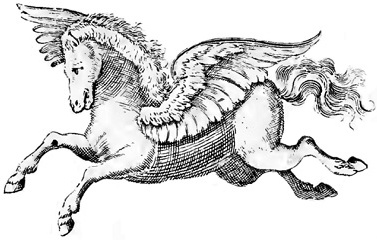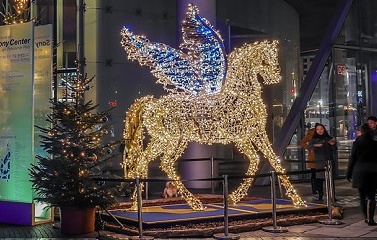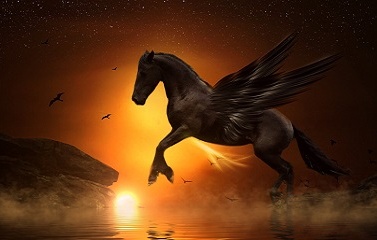What is a Pegasus?
Pegasus is a winged stallion, famous for the inspiration he gives to artists and the power he gives to heroes. He has enjoyed huge popularity since he first appeared in Greek mythology, and he continues to challenge our imaginations today.
Characteristics
Physical Description
Pegasus is a pure white stallion with a pair of feathered wings sprouting from his back. Although he was never saddled, he sometimes wore an enchanted golden bridle, made by Athena.
At the end of his life, Zeus transformed Pegasus into a constellation: a boxy body with an arched neck and two front legs.
Personality
At the beginning of his life, Pegasus was a wild but noble creature. He was drawn to clear, tranquil springs and to the Greek Muses, who inspired humans to pursue poetry, song, dance, art, history, and astronomy. Pegasus himself was an inspiring figure; countless painters and sculptors tried to capture his beauty and power.
Later in life, Pegasus was tamed. His masters led him to be more adventurous and warlike. He was especially connected to Zeus and Athena.
Special Abilities
Besides his ability to fly, which literally set him above all other horses, Pegasus had an arsenal of supernatural powers. He had free passage from the mortal realm to the immortal realm. Wherever his hoof struck the Earth, he created beautiful springs with water that could inspire artists. He was also responsible for carrying Zeus’s lightning bolts, and his wings could clap like thunder in the sky when he was in a bad mood.
Related Characters
At the time that Medusa was beheaded by Perseus, she was pregnant with Poseidon’s twins. The twins, Pegasus and Chrysaor, sprang from their mother’s mutilated body and flew into the wilderness.
Eventually, Pegasus and Chrysaor became separated, and Pegasus made his way to Mt. Helicon, where the Muses lived, hidden beneath the mountain. Here, Pegasus created a spring that released some of the Muse’s energy from the mountain.
Pegasus lived peacefully beside his new spring until his power began to attract attention. A hero, Bellerophon, recruited Pegasus by tricking him into wearing an enchanted bridle, made by Athena. Wearing this bridle, Pegasus went into battle with Bellerophon and defeated the Chimera. Later, Athena gave Pegasus to Perseus, to help him save Andromeda from a dragon.
At last, Zeus was attracted to the valor Pegasus had shown. He had the mighty horse brought to his own stables, where he gave him the special job of carrying his lightning bolts.
Cultural Representation
Greece
The legend of Pegasus springs from ancient Greek tales. He appears in the 2nd century AD, and throughout Greek times, he was mentioned by countless scholars, including Ovid, Hesiod, Pindar, and Plato. The white stallion was also hugely popular with Greek potters, who carved and painted him onto ornamental vases.
Renaissance
Among the many Greco-roman legends that Renaissance artists resurrected, Pegasus was one of the most popular. His connection to the Muses and artistic inspiration made him a favorite symbol among the artists who led the Renaissance movement. Even Leonardo da Vinci and Giovanna Battista embraced the winged stallion in their art.
Modern Appearances
Pegasus has held onto his place in folklore. He appears in fantasy works like Disney’s Fantasia and the bestselling Percy Jackson series.
He is also a popular logo in the transportation industry. Many cars, airplanes, and ships have been named after him.











This really helped me, Thanks
bro, this slayed my life it was so facinating
good info